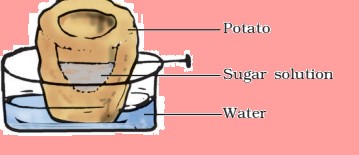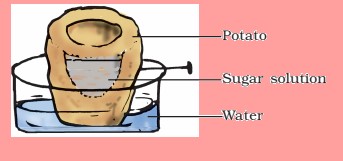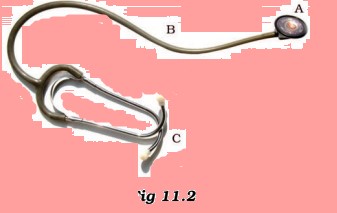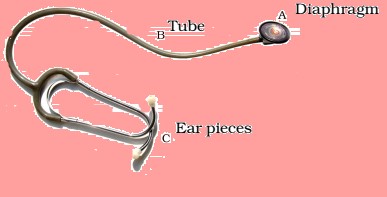Science
(www.olympiadsuccess.com)
Chapter 11: Respiration in Animals and Plants
Class VII
Multiple Choice Questions
Question 1
The muscular tube through which stored urine is passed out of the body is called –
(a) kidney
(b) ureter
(c) urethra
(d) urinary bladder
Answer 1
(c)
Question 2
They are pipe-like, consisting of a group of specialised cells. They transport substances and form a two-way traffic in plants. Which of the following terms qualify for the features mentioned above?
(a) Xylem tissue
(b) Vascular tissue
(c) Root hairs
(d) Phloem tissue
Answer 2
(d)
Question 3
The absorption of nutrients and exchange of respiratory gases between blood and tissues takes place in –
(a) veins
(b) arteries
(c) heart
(d) capillaries
Answer 3
(d)
Question 4
In which of the following parts of human body are sweat glands absent?
(a) Scalp
(b) Armpits
(c) Lips
(d) Palms
Answer 4
(c)
Question 5
In a tall tree, which force is responsible for pulling water and minerals from the soil?
(a) Gravitational force
(b) Transportation force
(c) Suction force
(d) Conduction force
Answer 5
(c)
Question 6
Aquatic animals like fish excrete their wastes in gaseous form as
(a) Oxygen
(b) Hydrogen
(c) Ammonia
(d) Nitrogen
Answer 6
(c)
Very Short Answer Questions
Question 7
Veins have valves which allow blood to flow only in one direction. Arteries do not have valves. Yet the blood flows in one direction only. Can you explain why?
Answer 7
Blood flow in arteries is rapid and at a high pressure. Also arteries have thick elastic walls.
Question 8
What is the special feature present in a human heart which does not allow mixing of blood when oxygen-rich and carbon dioxide-rich blood reach the heart?
Answer 8
Heart is partitioned into four chambers.
Question 9
Name the organ which is located in the chest cavity with its lower tip slightly tilted towards the left.
Answer 9
Heart.
Short Answer Questions
Question 10
Look at Figure 11.1. Draw another figure of the same set-up as would be observed after a few hours.

Answer 10

Question 11
Arrange the following statements in the correct order in which they occur during the formation and removal of urine in human beings.
(a) Ureters carry urine to the urinary bladder.
(b) Wastes dissolved in water is filtered out as urine in the kidneys.
(c) Urine stored in urinary bladder is passed out through the urinary opening at the end of the urethra.
(d) Blood containing useful and harmful substances reaches the kidneys for filtration.
(e) Useful substances are absorbed back into the blood.
Answer 11
(d) → (e) → (b) → (a) → (c)
Question 12
Paheli uprooted a rose plant from the soil. Most of the root tips, with root hairs got left behind in the soil. She planted it in a pot with new soil and watered it regularly. Will the plant grow or die? Give reason for your answer.
Answer 12
Possible answers are:
Question 13
(a) Name the only artery that carries carbon dioxide-rich blood.
(b) Why is it called an artery if it does not carry oxygen-rich blood?
Answer 13
(a) Pulmonary artery
(b) It is so because arteries carry blood away from the heart.
Sugar solution
Water
Potato
Question 14
Boojho’s uncle was hospitalised and put on dialysis after a severe infection in both of his kidneys.
(a) What is dialysis?
(b) When does it become necessary to take such a treatment?
Answer 14
(a) In dialysis, blood is filtered periodically through an
artificial kidney.
(b) In the event of kidney failure.
Question 15
Name the process and the organ which helps in removing the following wastes from the body.
(a) Carbondioxide
(b) Undigested food
(c) Urine
(d) Sweat
Answer 15
Process Organ
(a) exhalation - lungs
(b) egestion - large intestines and anus
(c) excretion - kidneys
(d) perspiration - sweat glands
(sweating)
Question 16

Observe Figure 11.2 and answer the given questions:
(a) Name the instrument.
(b) Label the parts A, B and C.
Answer 16

(a) The given instrument is stethoscope.
Question 17
Paheli noticed water being pulled up by a motor-pump to an overhead tank of a five-storeyed building. She wondered how water moves up to great heights in the tall trees standing next to the building. Can you tell why?
Answer 17
Hint: Transpiration generates a "suction pull" which draws water up the tall trees.
Long Answer Questions
Question 18
Match the parts of the heart in Column I with the direction of flow of blood in Column II.
Column I Column II
(i) Right ventricle (a) Pushes blood into the
pulmonary artery.
(ii) Pulmonary veins (b) Take deoxygenated blood
from the heart to lungs.
(iii) Left atrium (c) Receives blood from
different parts of the
body.
(iv) Pulmonary arteries (d) Bring oxygenated blood
from lungs to the heart.
(v) Left ventricle (e) Pushes blood into the
aorta.
(vi) Right auricle (f) Receives deoxygenated
blood from the
pulmonary veins.
Answer 18
(i) (a); (ii) (d); (iii) (f); (iv) (b); (v) (e); (vi) (c)
Question 19
Read the following terms given below. root hairs xylem urethra arteries kidneys veins atria capillaries heart ureter phloem urinary bladder
Group the terms on the basis of the categories given below.
(a) Circulatory system of animals.
(b) Excretory system in human.
(c) Transport of substances in plants.
Answer 19
(a) arteries, atria, capillaries, veins, heart.
(b) ureter, kidneys, urethra, urinary bladder.
(c) root hairs, xylem, phloem.
Question 20
Fill in the blanks of the following paragraph using just two words – arteries and veins.
___(a)___ carry oxygen-rich blood from the heart to all parts of the body and ___ (b)___ carry carbon dioxide-rich blood from all parts of the body back to the heart. ___ (c)___ have thin walls and __ (d)___ have thick elastic walls. Blood flows at high pressure in ___ (e)____. Valves are present in __ (f) ___ which allow blood to flow only towards the heart. __ (g)___ divide into smaller vessels. These vessels further divide into extremely thin tubes called capillaries. The capillaries join up to form ____ (h)_____.
Answer 20
(a) arteries (b) veins (c) veins
(d) arteries (e) arteries (f) veins
(g) arteries (h) veins.
Question 21
While learning to ride a bicycle Boojho lost his balance and fell. He got bruises on his knees and it started bleeding. However, the bleeding stopped after some time.
(a) Why did the bleeding stop?
(b) What would be the colour of the wounded area and why?
(c) Which type of blood cells are responsible for clotting of blood?
Answer 21
(a) A blood clot had formed.
(b) Dark red due to clotting of blood.
(c) Platelets.
Diaphragm
Tube
Ear pieces
Yearlong program for Olympiads preparation & to build necessary skills for future.
Explore More
Time to mark your calendar with the upcoming Olympiads exam schedule.
Explore More
Take your Olympiad preparation to next-level by taking LIVE Classes.
Explore More
Assess your performance by taking topic-wise and full length mock tests.
Explore More
Online tuitions for international compeitions like SASMO, SEAMO, etc for Grades 1-11.
Explore More